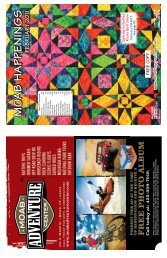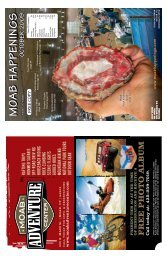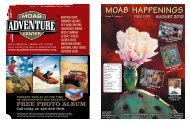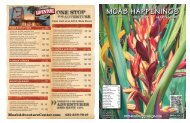Moab Happenings
Moab Happenings
Moab Happenings
You also want an ePaper? Increase the reach of your titles
YUMPU automatically turns print PDFs into web optimized ePapers that Google loves.
14B • March 2011 • <strong>Moab</strong> <strong>Happenings</strong><br />
DOG AGILITY HAPPENINGS<br />
www.moabhappenings.com<br />
Agility Returns to <strong>Moab</strong>! by Diane Allen<br />
The Old Spanish Trail Arena will be the site of two dog<br />
agility trials, sponsored by the North American Dog Agility<br />
Council (NADAC), on April 2-3 and April 9-10, 2011.<br />
Competition begins at 9 a.m. each day. Dogs from all over<br />
the intermountain west and beyond, as well as several <strong>Moab</strong><br />
canines, will be competing over timed, judged courses of<br />
jumps, ramps, tunnels and the ever-popular-with-spectators<br />
weave poles. Mixed breed as well as purebred competitors<br />
are judged on their speed, accuracy and safety as they<br />
zoom around a variety of courses, ten to twenty obstacles<br />
long. The two-legged member of each team is responsible<br />
for keeping the dogs on the correct courses<br />
(most four-leggeds haven’t learned to read the<br />
numbers!), as well as ensuring safe performance<br />
of each obstacle.<br />
The North American Dog Agility Council<br />
(NADAC) is one of several organizations that<br />
sponsor agility competitions. NADAC was<br />
formed in 1993, to provide North American dogs<br />
and their handlers with a fast, safe and enjoyable<br />
form of the sport of dog agility. The purpose of a<br />
NADAC agility trial is to demonstrate the ability<br />
of a dog and its handler to work as a smoothly<br />
functioning team. With separate titling divisions<br />
for Veterans and Junior Handlers and a variety<br />
of games, NADAC agility offers something<br />
for everyone! Based in Oklahoma, NADAC<br />
sponsors competitions all over North America<br />
and Australia.<br />
What obstacles are used?<br />
• Jumps – Jumps are set at the proper height<br />
for each class, determined by the height of the dog at the<br />
withers (shoulders). Veteran dogs or those running with<br />
veteran handlers, junior handlers, and the Skilled class<br />
dogs can jump lower than their normal height. Dogs must<br />
clear the full height of the jump without knocking a bar off.<br />
Handlers sometimes run into the uprights and knock bars;<br />
that’s also a fault!<br />
• Tunnels – An easy obstacle to train, but many dogs<br />
suffer from “tunnel suck!”<br />
• Contact Obstacles - The contact obstacles, so called<br />
because of the “contact zones” at lower end, include the<br />
A-frame and the dogwalk. To perform these obstacles<br />
correctly, the dog must get at least one paw in each contact<br />
zone when they descend the obstacle. The contact zone rule<br />
is for safety considerations.<br />
• Weave Poles - The dog must enter to the right of the<br />
first pole and zig-zag through to the end. They must not<br />
miss a pole. If a dog “pops out” before the last pole, they<br />
must restart from the beginning.<br />
• Hoops - Similar to a hula-hoop on its edge, a<br />
hoop is the ultimate “ground speed obstacle.” While they<br />
look easy, handlers must direct the dog while she is going<br />
full speed.<br />
How are runs judged?<br />
Faults occur if the handler touches the dog or an<br />
obstacle while on course, or if the dog runs the wrong<br />
course, misses a contact zone, misses a weave pole or fails<br />
to complete the set, displaces a jump bar, or exceeds the<br />
amount of time set by the judge for running the course.<br />
Different classes allow different numbers of faults to be<br />
considered “qualifying.” A certain number of qualifying<br />
rounds will result in a title being earned.<br />
Dogs are entered, depending upon their experience<br />
and previously-earned titles, at the Novice, Open or Elite<br />
level. There are special divisions for Veterans (dogs age<br />
7 years or older, or handlers age 60 years or older) and<br />
Junior Handlers (age 17 or younger). NADAC offers<br />
the Proficient class, in which dogs must have no faults<br />
to qualify, and the Skilled class, in which dogs can have<br />
five faults (e.g., one knocked bar) or be up to five seconds<br />
over time and still qualify. In addition, dogs running in the<br />
Skilled class jump one height lower than their usual.<br />
What events are offered?<br />
• Regular Class requires that the dog, under the<br />
direction of the handler, perform all of the agility obstacles<br />
in the order and under the time limit set by the judge. There<br />
are usually two regular classes offered each day.<br />
• Chances Class offers tests in direction, distance, and<br />
discrimination between two obstacles. There are 10 to 15<br />
obstacles, and each level has one, two or three tests (Elite<br />
having all three). All dogs have 40 seconds to complete<br />
this class.<br />
• Jumpers Class is composed only of jumps and<br />
tunnels, and can be fast and furious!<br />
• Touch ‘n’ Go consists of the contact obstacles<br />
(A-frame and dog walk) and tunnels.<br />
• Weavers consists of just weave poles and tunnels.<br />
Each level has a different number of poles, with either six<br />
or ten/twelve poles per set. Novice dogs will run three<br />
short sets, while Elite dogs see three long sets.<br />
• Tunnelers –yep! You guessed it! –consists of just<br />
tunnels!<br />
• Hoopers – a new class, where “ground speed<br />
obstacles” which look like hula-hoops on edge must be<br />
negotiated. The rules are rather complicated to explain –<br />
suffice to say, handlers can get easily confused, and most<br />
end up in hysterical laughter before the end! Hoops are<br />
used in some of the other classes as well.<br />
Why Do People Do This?!<br />
Agility is great for dogs and people for a number of<br />
reasons.<br />
• It can build confidence in shy or nervous dogs. Once<br />
they figure out they can do the obstacles, they tend to love<br />
it!<br />
• It provides a safe and fun outlet for a dog’s energy.<br />
• It provides a competitive environment where a dog<br />
and handler can compete not against other dogs, but just<br />
against the course and themselves.<br />
• It builds a strong and loving bond between dog and<br />
handler. Training should always be more fun than work, and<br />
trainers should always set it up so the dog is never wrong.<br />
Dogs respond much better to positive reinforcement, and it<br />
shows in their success.<br />
What happens at an event?<br />
When the course has been set up, the handlers<br />
gather together for a “judge’s briefing” where the judge<br />
MAILBOX RENTALS<br />
PRIVATE & SECURE<br />
• 3 DIFFERENT SIZES<br />
• MAIL FORWARDING AVAILABLE<br />
• AS A MAILBOX CUSTOMER,<br />
YOU CAN RECEIVE UPS & FEDEX<br />
Forget something?<br />
UPS & FedEx offer overnight<br />
services in <strong>Moab</strong>!<br />
summarizes how the class is judged. Then the handlers<br />
may “walk the course.” They do this as a group, without<br />
their dogs, following the numbers to become familiar<br />
with how the course goes. Most handlers try to walk the<br />
course as many times as they can in the time allotted, to<br />
plan their strategy. You may see handlers during a course<br />
walk actually running the course with an imaginary dog,<br />
giving the commands as they would during their competing<br />
round. Sometimes handlers gather in little groups and<br />
discuss challenges and how they are going to handle them.<br />
The dogs run the course individually, in a predetermined<br />
order, off leash and without collars (for<br />
safety reasons). The judge will tell the handler when<br />
he or she may begin, and the timer starts the clock<br />
as soon as the dog crosses the start line and stops it<br />
when the dog crosses the finish. As each dog runs, the<br />
judge indicates the faults, which are noted on a sheet<br />
of paper by the scribe. At the completion of the round,<br />
the scribe records the dog’s time. The information is<br />
then conveyed to the scorekeeper, who calculates the<br />
qualifying performances and top placements. These<br />
are usually then posted somewhere for competitors<br />
to see.<br />
Spectators are welcome; there is no admission<br />
fee. Dogs that are not entered are discouraged<br />
from attending.<br />
A few rules will keep everyone happy and<br />
healthy:<br />
• Before you reach out to pet a dog, always ask<br />
the owner/handler FIRST. Please especially be sure<br />
your children observe this rule. Please supervise your<br />
children at all times.<br />
• Feel free to sit or stand ringside and observe, but<br />
please remember to stay back a reasonable distance from<br />
the ring itself and especially stay away from ring entrances<br />
and exits.<br />
• It is against the rules for spectators to assist or coach<br />
the handler/dog team by, for example, yelling out the<br />
correct obstacle order from the sidelines. (Yes, handlers<br />
do sometimes get confused or lost on course!) It is also<br />
not appropriate to shout the dog’s name, since this would<br />
distract the dog from the handler’s commands.<br />
• Please do feel free to applaud and cheer the dogs on,<br />
and show your appreciation at the END of a particularly<br />
good or entertaining run.<br />
Several <strong>Moab</strong> dogs are entered in these trials. Come<br />
and cheer for them and all the others!<br />
375 South Main<br />
Corner of Main St. & Grand Ave.<br />
Open Monday - Friday 8 a.m. to 6 p.m.<br />
Saturday 9 a.m. to 5 p.m.<br />
�������������������<br />
AUTHORIZED<br />
SHIPPING<br />
OUTLET








